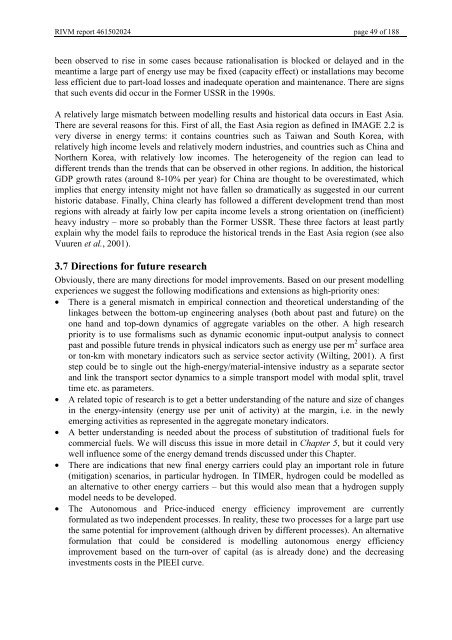Targets IMage Energy Regional (TIMER) Model, Technical ...
Targets IMage Energy Regional (TIMER) Model, Technical ...
Targets IMage Energy Regional (TIMER) Model, Technical ...
Create successful ePaper yourself
Turn your PDF publications into a flip-book with our unique Google optimized e-Paper software.
RIVM report 461502024 page 49 of 188<br />
been observed to rise in some cases because rationalisation is blocked or delayed and in the<br />
meantime a large part of energy use may be fixed (capacity effect) or installations may become<br />
less efficient due to part-load losses and inadequate operation and maintenance. There are signs<br />
that such events did occur in the Former USSR in the 1990s.<br />
A relatively large mismatch between modelling results and historical data occurs in East Asia.<br />
There are several reasons for this. First of all, the East Asia region as defined in IMAGE 2.2 is<br />
very diverse in energy terms: it contains countries such as Taiwan and South Korea, with<br />
relatively high income levels and relatively modern industries, and countries such as China and<br />
Northern Korea, with relatively low incomes. The heterogeneity of the region can lead to<br />
different trends than the trends that can be observed in other regions. In addition, the historical<br />
GDP growth rates (around 8-10% per year) for China are thought to be overestimated, which<br />
implies that energy intensity might not have fallen so dramatically as suggested in our current<br />
historic database. Finally, China clearly has followed a different development trend than most<br />
regions with already at fairly low per capita income levels a strong orientation on (inefficient)<br />
heavy industry – more so probably than the Former USSR. These three factors at least partly<br />
explain why the model fails to reproduce the historical trends in the East Asia region (see also<br />
Vuuren HWDO, 2001).<br />
'LUHFWLRQVIRUIXWXUHUHVHDUFK<br />
Obviously, there are many directions for model improvements. Based on our present modelling<br />
experiences we suggest the following modifications and extensions as high-priority ones:<br />
• There is a general mismatch in empirical connection and theoretical understanding of the<br />
linkages between the bottom-up engineering analyses (both about past and future) on the<br />
one hand and top-down dynamics of aggregate variables on the other. A high research<br />
priority is to use formalisms such as dynamic economic input-output analysis to connect<br />
past and possible future trends in physical indicators such as energy use per m 2 surface area<br />
or ton-km with monetary indicators such as service sector activity (Wilting, 2001). A first<br />
step could be to single out the high-energy/material-intensive industry as a separate sector<br />
and link the transport sector dynamics to a simple transport model with modal split, travel<br />
time etc. as parameters.<br />
• A related topic of research is to get a better understanding of the nature and size of changes<br />
in the energy-intensity (energy use per unit of activity) at the margin, i.e. in the newly<br />
emerging activities as represented in the aggregate monetary indicators.<br />
• A better understanding is needed about the process of substitution of traditional fuels for<br />
commercial fuels. We will discuss this issue in more detail in &KDSWHU, but it could very<br />
well influence some of the energy demand trends discussed under this Chapter.<br />
• There are indications that new final energy carriers could play an important role in future<br />
(mitigation) scenarios, in particular hydrogen. In <strong>TIMER</strong>, hydrogen could be modelled as<br />
an alternative to other energy carriers – but this would also mean that a hydrogen supply<br />
model needs to be developed.<br />
• The Autonomous and Price-induced energy efficiency improvement are currently<br />
formulated as two independent processes. In reality, these two processes for a large part use<br />
the same potential for improvement (although driven by different processes). An alternative<br />
formulation that could be considered is modelling autonomous energy efficiency<br />
improvement based on the turn-over of capital (as is already done) and the decreasing<br />
investments costs in the PIEEI curve.
















